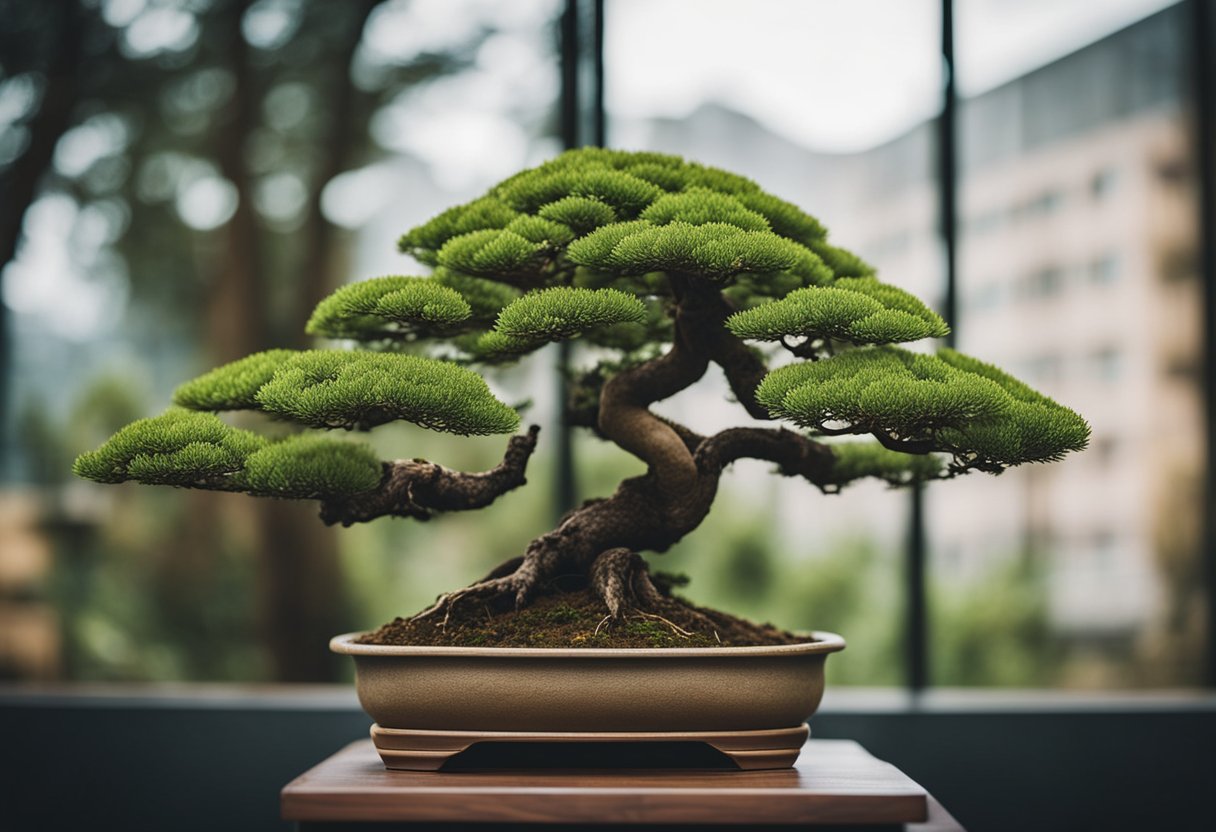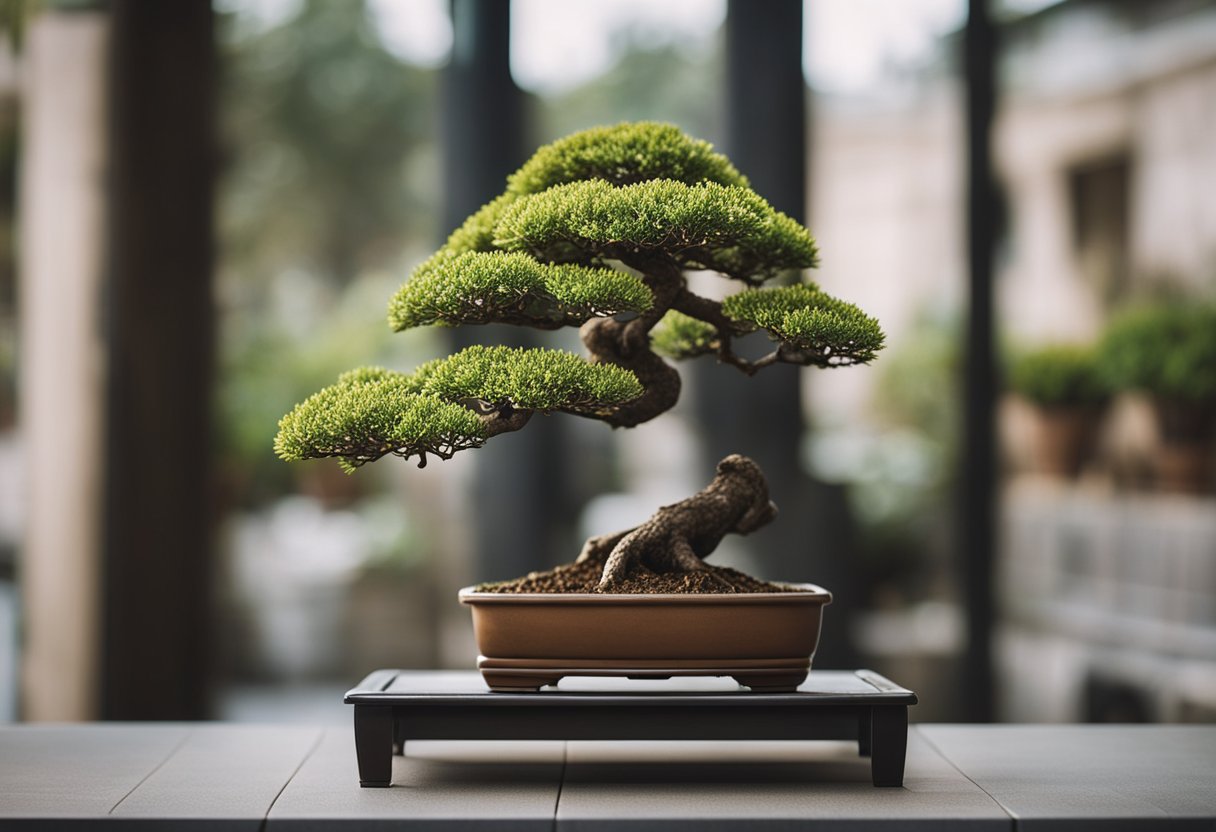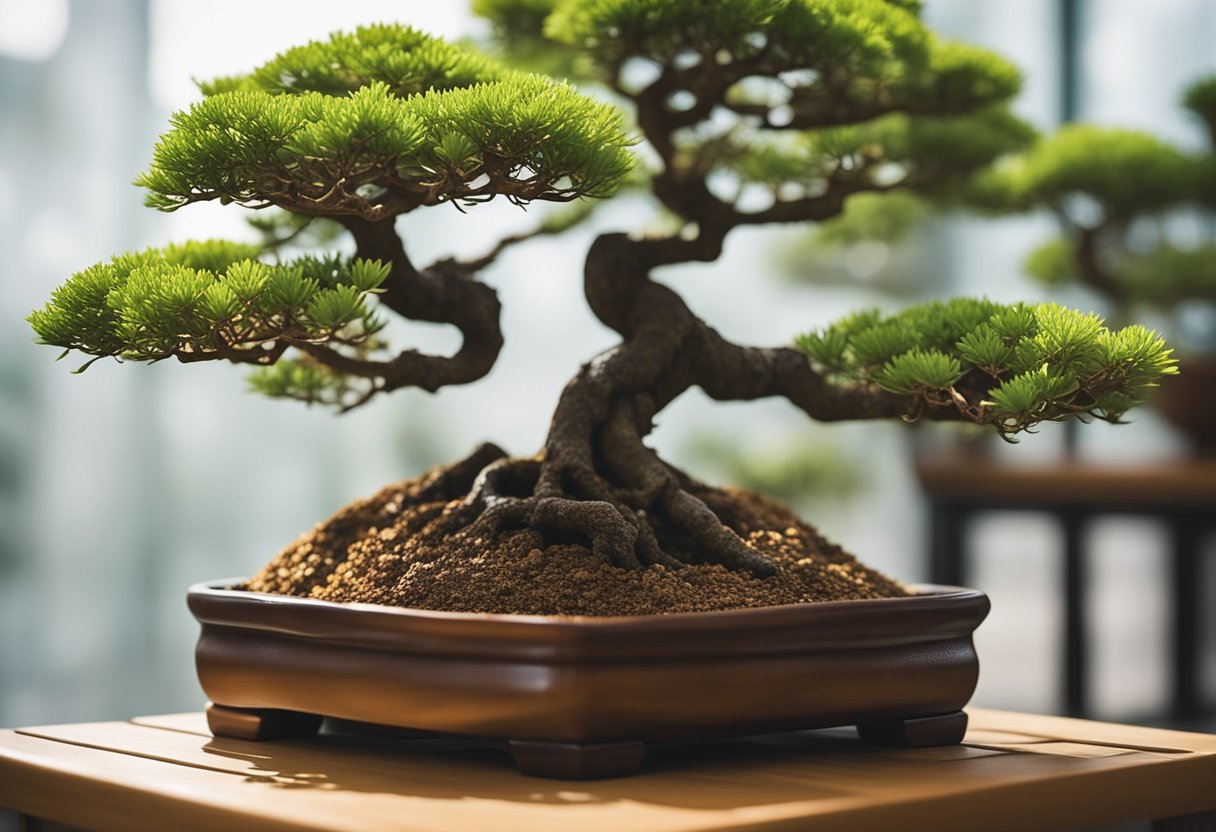Why Is My Bonsai Turning Brown? Common Causes and Solutions.
Bonsai trees are known for their unique aesthetic and require a special kind of care and attention. One of the most common issues that bonsai tree owners face is the browning of the leaves and branches. This can be a cause of concern, especially if you have put in a lot of effort and time into caring for your tree.
This post may contain affiliate links, which means I’ll receive a commission if you purchase through my link, at no extra cost to you. Please read full disclosure here.

There are several reasons why a bonsai tree may turn brown. One of the most common reasons is a lack of water or overwatering. Bonsai trees require a specific amount of water to survive and stay healthy. Too little or too much water can cause the leaves and branches to turn brown. Another reason could be a lack of nutrients or sunlight. Bonsai trees require the right balance of nutrients and sunlight to thrive. If they are not getting enough of either, they may start to turn brown.
If you are experiencing this issue with your bonsai tree, it is important to identify the cause so that you can take the necessary steps to revive it. In this article, we will explore some of the common causes of bonsai trees turning brown and provide troubleshooting tips and solutions to bring back its vibrant green color. By following the advice in this article, you can ensure that your bonsai tree stays healthy and beautiful for years to come.
Understanding Bonsai Trees

Bonsai trees are miniature trees that are grown in small pots and are pruned and trained to grow into a particular shape. They are a popular form of art and have been cultivated for centuries. Bonsai trees come in many different species and require specific care to thrive.
One important aspect of caring for bonsai trees is understanding their species-specific needs. Different species of bonsai trees have different requirements for water, light, and soil. For example, some species of bonsai trees prefer a more humid environment, while others prefer a drier environment. It is important to research the specific needs of your bonsai tree to ensure it is receiving the proper care.
Another important aspect of caring for bonsai trees is understanding their watering needs. Over-watering or under-watering can cause stress to the tree and lead to browning leaves. It is important to water your bonsai tree regularly and to monitor the soil moisture levels. A general rule of thumb is to water your bonsai tree when the soil is slightly dry to the touch.
In addition to watering, light is also an important factor in the health of your bonsai tree. Some species of bonsai trees require more sunlight than others. It is important to research the specific light requirements of your bonsai tree and to place it in an area where it can receive the appropriate amount of light.
Overall, understanding the specific needs of your bonsai tree is crucial for its health and longevity. Proper care, including watering, light, and soil, can help prevent browning leaves and ensure your bonsai tree thrives.
Common Causes for Bonsai Turning Brown

Bonsai trees are delicate and require specific care to thrive. Brown leaves on a bonsai tree can be a sign of stress, and it is essential to identify the cause to prevent further damage. Here are some of the most common causes of browning in bonsai trees:
Improper Watering
One of the most common causes of browning in bonsai trees is improper watering. Overwatering or underwatering can lead to stress and cause the leaves to turn brown. It is essential to maintain a proper watering schedule based on the species of your bonsai tree and the size of the pot it is in. A good rule of thumb is to water your bonsai when the top inch of soil feels dry to the touch.
Lack of Light
If your bonsai tree isn’t getting enough light, it may turn brown because it will struggle to produce chlorophyll. If this happens, you will need to move your tree to a place with better light. A windowsill is often a good option, but bear in mind that some bonsai trees also don’t like getting lots of bright, direct sun.
Environmental Factors
Bonsai trees require specific conditions to thrive, and any deviation from these conditions can lead to browning. For example, if your bonsai tree is exposed to extreme temperatures, it may turn brown. Similarly, if your tree is located in a drafty area, it may become stressed and turn brown.
Root Issues
Root issues can also cause browning in bonsai trees. If the roots are damaged or rotting, the tree may not be able to absorb water and nutrients properly, leading to stress and brown leaves. It is essential to inspect your bonsai tree’s roots regularly and repot it when necessary to prevent root issues.
Pests and Diseases
Pests and diseases can also cause browning in bonsai trees. Spider mites, scale insects, and aphids are common pests that can damage bonsai trees and cause brown leaves. Fungal and bacterial diseases can also cause browning. It is essential to inspect your bonsai tree regularly and treat any pest or disease issues promptly to prevent further damage.
In summary, there are different issues that can cause a brown bonsai tree. Improper watering, lack of light, environmental factors, root issues, pests, and diseases are some of the most common causes of browning in bonsai trees. It is essential to identify the cause of the problem and take appropriate action to prevent further damage.
Watering Issues
Bonsai trees require a careful balance of water to thrive. Over or under-watering can cause the leaves to turn brown. Therefore, it is essential to have a proper watering schedule and to monitor the moisture levels in the soil.
Overwatering
Overwatering is a common problem that can lead to root rot and cause the leaves to turn brown. When the soil is too wet, the roots cannot absorb oxygen, which can lead to their death. As a result, the tree cannot absorb nutrients, and the leaves may start to turn brown.
To avoid overwatering, it is recommended to water the tree only when the soil is slightly dry. It is also important to ensure that the pot has proper drainage to allow excess water to escape.
Underwatering
On the other hand, too little water can also cause the leaves to turn brown. When the soil is too dry, the roots cannot absorb enough water, which can lead to dehydration. As a result, the tree may start to wilt, and the leaves may turn brown.
To avoid underwatering, it is recommended to water the tree thoroughly when the soil is dry. However, it is important not to water the tree too frequently, as this can lead to overwatering.
In summary, improper watering is one of the most common causes of brown leaves in bonsai trees. It is important to have a proper watering schedule and to monitor the moisture levels in the soil to ensure that the tree receives the right amount of water.
Nutrient Deficiencies
One of the reasons why a bonsai tree may turn brown is due to a lack of nutrients. Bonsai trees require regular fertilization to ensure they receive the necessary nutrients for growth and development. A nutrient deficiency can cause the leaves to turn brown as the tree is unable to produce chlorophyll, which is responsible for the green color.
Nitrogen Deficiency
Nitrogen is an essential nutrient for the growth of bonsai trees. A lack of nitrogen can cause the leaves to turn yellow or brown, and the tree may stop growing. Nitrogen is responsible for the production of chlorophyll, which is necessary for photosynthesis. Without enough nitrogen, the tree cannot produce enough chlorophyll, which results in the leaves turning brown.
To prevent nitrogen deficiency, it is important to use a fertilizer that is high in nitrogen. Bonsai trees should be fed with a balanced fertilizer every two weeks during the growing season.
Potassium Deficiency
Potassium is another essential nutrient for the growth of bonsai trees. A lack of potassium can cause the leaves to turn brown and curl up at the edges. Potassium is responsible for maintaining the water balance in the tree, and it is necessary for the production of carbohydrates.
To prevent potassium deficiency, it is important to use a fertilizer that is high in potassium. Bonsai trees should be fed with a balanced fertilizer every two weeks during the growing season.
Magnesium Deficiency
Magnesium is an important nutrient for the growth of bonsai trees. A lack of magnesium can cause the leaves to turn yellow or brown, and the tree may stop growing. Magnesium is responsible for the production of chlorophyll, and it is necessary for photosynthesis.
To prevent magnesium deficiency, it is important to use a fertilizer that is high in magnesium. Bonsai trees should be fed with a balanced fertilizer every two weeks during the growing season.
In conclusion, nutrient deficiencies can cause a bonsai tree to turn brown. It is important to use a balanced fertilizer that contains the necessary nutrients for the growth and development of the tree. By providing the tree with the right nutrients, it can remain healthy and vibrant.
Pests and Diseases
Bonsai trees are susceptible to various pests and diseases that can cause them to turn brown. Insect pests and fungal infections are the most common culprits.
Insect Pests
Insects like spider mites, aphids, and scale insects can infest bonsai trees and cause damage to the leaves and branches, leading to browning. Spider mites are tiny pests that can be difficult to see with the naked eye. They feed on the sap of the tree, causing yellowing and browning of the leaves. Aphids are small, pear-shaped insects that feed on the sap of the tree, causing the leaves to curl and turn brown. Scale insects are small, oval-shaped pests that attach themselves to the bark of the tree and feed on the sap, causing the leaves to turn yellow and brown.
To prevent insect infestations, it is important to keep the bonsai tree healthy and well-maintained. Regularly inspect the tree for signs of pests and remove any affected leaves or branches. Use insecticidal soap or neem oil to control infestations.
Fungal Infections
Fungal infections can also cause browning in bonsai trees. Fungi like root rot and powdery mildew can affect the tree’s health and cause browning of the leaves. Root rot is caused by overwatering and poor drainage, leading to the decay of the roots. Powdery mildew is a fungal disease that appears as a white, powdery coating on the leaves and stems of the tree.
To prevent fungal infections, ensure that the bonsai tree is planted in well-draining soil and avoid overwatering. Use fungicides to control fungal infections.
In conclusion, pests and diseases can cause bonsai trees to turn brown. Regular inspection and proper care can help prevent infestations and infections, ensuring the health and beauty of the bonsai tree.
Environmental Factors
Bonsai trees are sensitive to their environment and require specific conditions to thrive. Any deviation from these conditions can cause the leaves to turn brown. In this section, we will discuss the environmental factors that can cause a bonsai tree to turn brown.
Light and Temperature
Light and temperature are two important environmental factors that can affect the health of a bonsai tree. Bonsai trees require bright, indirect sunlight to grow properly. Direct sunlight can scorch the leaves and cause them to turn brown. On the other hand, insufficient light can cause the leaves to wilt and turn brown.
Extreme temperatures can also have a negative impact on bonsai trees. If the temperature drops too low, the leaves can freeze and turn brown. On the other hand, if the temperature is too high, the leaves can become dehydrated and turn brown.
Humidity
Humidity levels can also affect the health of a bonsai tree. Bonsai trees require a certain level of humidity to thrive. If the humidity is too low, the leaves can dry out and turn brown. On the other hand, if the humidity is too high, the leaves can become waterlogged and turn brown.
Outdoor and Indoor Conditions
Bonsai trees can be grown both indoors and outdoors. However, the conditions in which they are grown can affect their health. If a bonsai tree is grown outdoors, it is exposed to natural elements such as wind, rain, and sunlight. Indoor bonsai trees are protected from these elements, but they may not receive enough sunlight or humidity.
Overall, it is important to consider the environmental factors when growing a bonsai tree. By providing the right amount of light, temperature, and humidity, you can ensure that your bonsai tree stays healthy and does not turn brown.
Prevention and Treatment
Prevention Tips
Preventing a bonsai tree from turning brown requires some knowledge and care. Bonsai enthusiasts must be aware of the various factors that can cause browning of leaves and take important steps to prevent them. Some important prevention tips are:
-
Watering: Watering is one of the most important factors to keep a bonsai tree healthy. Too little water can cause the leaves to dry out and turn brown, while too much water can cause root rot. Bonsai trees need to be watered regularly, but not excessively. The frequency of watering depends on the type of bonsai tree, the season, and the environment.
-
Fertilizing: Bonsai trees require proper nutrients to stay healthy. Lack of nutrients can cause yellowing or browning of leaves. Bonsai enthusiasts should fertilize their trees regularly with a balanced fertilizer to ensure that they get the necessary nutrients.
-
Pruning: Pruning is an important technique to maintain the shape and beauty of a bonsai tree. Pruning also helps to remove dead or diseased foliage, which can cause browning of leaves.
-
Environment: Bonsai trees need to be placed in an environment that is suitable for their growth. They need adequate light, humidity, and temperature to thrive. Bonsai enthusiasts should also protect their trees from extreme weather conditions, such as winter frost or summer heat.
-
Repotting: Repotting is an important ritual that helps to maintain the health of a bonsai tree. Bonsai enthusiasts should repot their trees every 2-3 years to ensure that the roots have enough space to grow and get the necessary nutrients.
Reviving a Brown Bonsai Tree
If a bonsai tree has already turned brown, it is not too late to save it. Bonsai enthusiasts can follow some important steps to treat and revive their brown bonsai trees. Some important tips for reviving a brown bonsai tree are:
-
Identify the cause: The first step in treating a brown bonsai tree is to identify the cause of the problem. The most common reasons behind browning of leaves are lack of water, pests, diseases, or environmental stress. Once the cause is identified, bonsai enthusiasts can take the appropriate steps to treat it.
-
Watering: If the brown bonsai tree is caused by too little water, bonsai enthusiasts should water it immediately. They should water the tree thoroughly until the water drains out of the pot. They should also mist the foliage to increase humidity.
-
Fungicide or insecticide: If the brown bonsai tree is caused by pests or diseases, bonsai enthusiasts can use a fungicide or insecticide to treat it. They should follow the instructions on the label carefully and use the appropriate amount of product.
-
Neem oil: Neem oil is a natural and effective remedy for treating pests and diseases in bonsai trees. Bonsai enthusiasts can mix neem oil with water and spray it on the foliage and soil.
-
Repotting: If the brown bonsai tree is caused by root rot, bonsai enthusiasts should repot it immediately. They should remove the affected roots and soil and replace them with fresh soil.
-
Insecticidal soap: Insecticidal soap is another natural and effective remedy for treating pests in bonsai trees. Bonsai enthusiasts can mix insecticidal soap with water and spray it on the foliage and soil.
-
Hardy species: Bonsai enthusiasts should choose hardy species, such as juniper or azalea, that are less prone to browning of leaves. They should also choose species that are suitable for their environment and climate.
By following these prevention tips and treatment steps, bonsai enthusiasts can prevent and treat browning of leaves in their bonsai trees and enjoy their beauty for years to come.